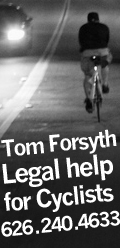A decent LA Times article (in contrast to the other one)

Thread started by
Sir Terrence Tuppins at 08.13.07 - 10:50 am
This is a decent, pro-bicycle article LA TIme article worth reading.
http://www.latimes.com/features/health/la-he-traffic13aug13,0,1299381.story?coll=la-home-middleright
And while we're talkin' about motorists vs. bicyclists...I've been in Philly for the past 7 months. The motorists here are truly insane. They make LA motorists seem like kind, rational-thinking people in comparison.
-------------------------------------------------------------------
On the mean streets of L.A.
Bicyclists and runners just want to share the pavement with drivers. They're entitled, right?
By Jeannine Stein, Los Angeles Times Staff Writer
August 13, 2007
Scott Sing has had a tire iron hurled at him, a water bottle thrown at his head and been bombarded with racial epithets. And all he was trying to do was ride his bike on Los Angeles city streets.
His cycling and running brethren tell similar tales -- of being peppered with flying objects, cursed or otherwise assaulted -- and those don't even include the stories of near-misses and actual collisions. Such are the perils of trying to do something healthful in a city that's not known as bike- or pedestrian-friendly.
Many like Sing, 48, who have been on the roads for years say that the hostility and congestion are getting worse, especially as traffic worsens and drivers become more distracted by cellphones and other electronic gadgets. Cyclists in particular have borne the brunt of the road rage because they most often have to share the asphalt with the four-wheeled. And, judging from the frequent shouted demands to get off the road, many drivers are unaware that cyclists have as much right to the streets as they do.
In Los Angeles County, bicycle-related accidents have increased slightly in the past year, according to the California Office of Traffic Safety. There were 25 deaths and 2,885 injuries in 2005 and an estimated 28 deaths and 2,910 injuries in 2006.
Statewide, fatalities numbered 120 in 2002 and about 155 in 2006. Injuries, however, which had gone up and down since 2001, declined last year, from 10,428 in 2005 to about 10,275 in 2006 (the office doesn't have any theories why).
The number of run-ins could rise further, cycling enthusiasts fear, as more people turn to bikes as an alternative means of transportation, or to get fit, or both.
At the nonprofit Bicycle Kitchen, volunteer Monica Howe reports a waiting list of wannabe members, and at the L.A. County Bicycle Coalition, where she is outreach coordinator, membership is up 50% over last year. "People are coming in all the time saying, 'I just sold my car and I'm going to do this by bike,' or that they've moved from cities where they rode a bike."
Wholesale sales of bikes rose from $2.6 billion in 2002 to $4 billion in 2006, reports the Washington D.C.-based Sporting Goods Manufacturers Assn. The group also found that increasing numbers of cyclists are hitting the streets, with 36.1 million people riding on roads or paved surfaces in 2005, and 39.4 million in 2006.
With the state Legislature considering nine bike-related bills this year, however, cyclists may finally begin to get some respect. Among them are measures that would double funds to the State Bicycle Transportation Account, mandate lights at night, require vehicles to pass bikes at a minimum distance of 3 feet and ensure that community transportation meet the needs of everyone who uses the roads -- cyclists, pedestrians and motorists.
And in June, the Metropolitan Transportation Authority debuted bus ads reminding drivers that cyclists belong on the roadways too. "I think cyclists appreciate the recognition," says Matt Raymond, the MTA's chief communications officer.
Road safety tips have also become an integral part of running and cycling training groups.
"There are definitely road-rage issues, which is why we're passionate about educating people," says Liz Elliott, co-director of Cyclists Inciting Change Thru Live Exchange, an L.A.-based bicycle advocacy group. "We teach people how to avoid negative experiences," some of which are avoidable, such as going through lights and whipping around corners.
Other common mistakes by riders are darting in and out between parked cars, not wearing reflective clothing or lights at night, riding on sidewalks and failing to follow traffic rules. Runners who go with the flow of traffic, often in the road, also risk getting hit.
"We also teach people not to engage," Elliott adds.
Dan Gutierrez is a certified traffic skills cycling instructor and a board member of the California Assn. of Bicycling Organizations. "A lot of what we do in our education work is teach cyclists how to act like a driver," he says. "When you ride at the edge of the road, cars will pass you closely because they think they've got enough room to squeeze by. But when you move further left, motorists can see you much farther back," causing them to change lanes and pass safely. "That whole way of thinking is not understood."
Though most cyclists and runners hope that drivers will eventually be more considerate, they know it's going to take massive social and infrastructure change to achieve that.
"It's about quality-of-life issues," says Elliott.
"If we're going to create a livable society, we're going to have to change the way we treat people on roadways."
jeannine.stein@latimes.com
reply -->
-->



